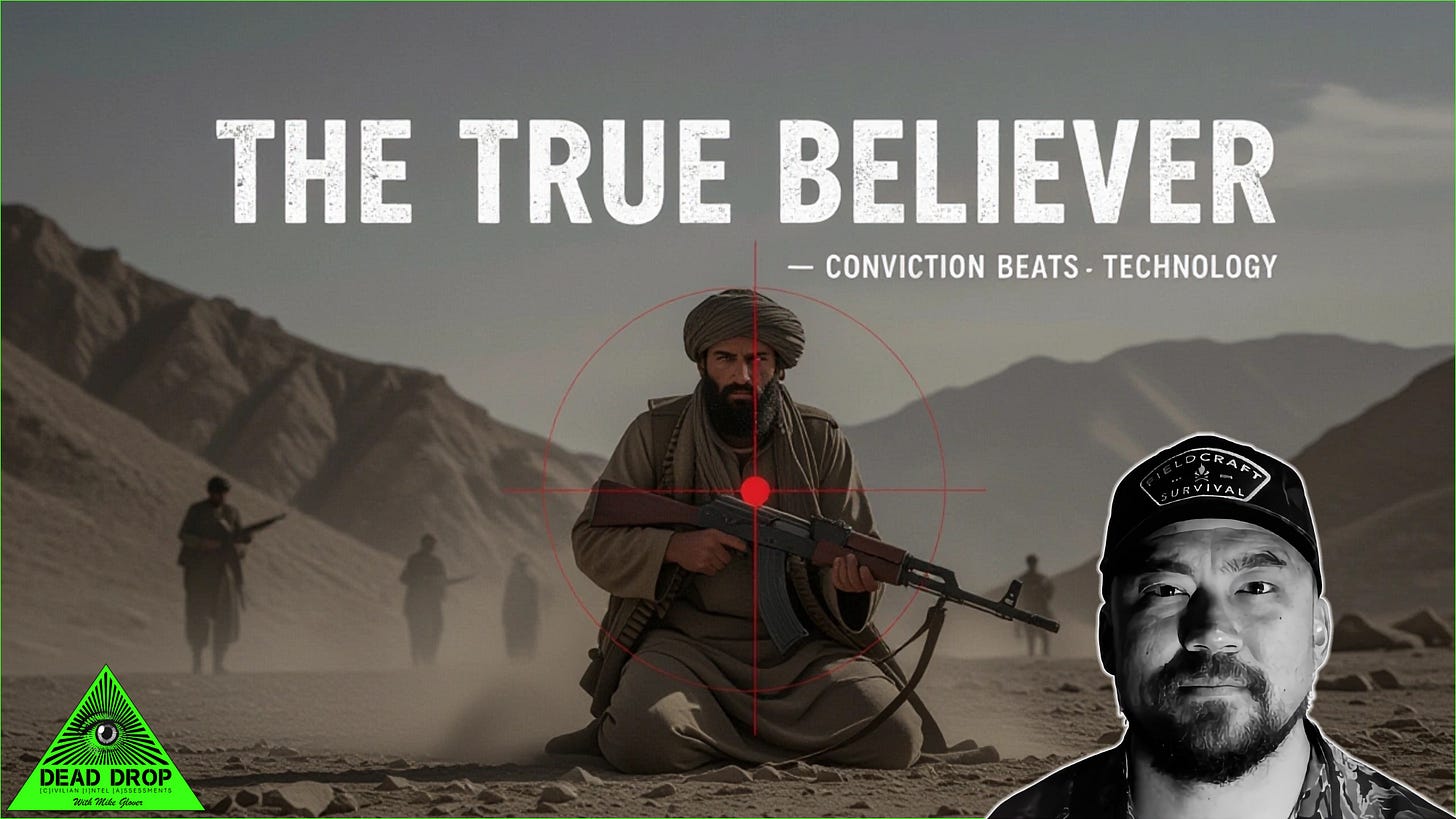The True Believer and the Future of War
Why ideology - not firepower - may decide who wins tomorrow’s wars
The danger in the terrorists who grew up in the hinterlands isn’t their ideology alone. It’s their capability. They are bred in the low-tech. Every single thing they do, from childhood to adulthood, is rooted in hardship, resourcefulness, and adaptation.
They learn to survive in the mountains of Afghanistan, to move through terrain without logistics, to fight without comfort, and to win without advantage. That’s their baseline. They don’t need convenience. They don’t need connectivity. They don’t even need hope the way we define it. What they have is conviction.
There’s an old story about the true believer. Nothing is more dangerous than a man who fully believes in his cause, no matter how misguided that cause might be. When that belief meets capability, especially in environments that most of the modern world can’t operate in, it becomes a force multiplier.
Keep reading below …
DISCLOSURE: This post contains affiliate links. If you make a purchase through them, we may earn a small commission at no extra cost to you. This helps keep our work independent. Thank you for your support.
The Low-Tech Advantage
The low-tech fighter understands something that modern militaries often forget. Technology is a tool, not a crutch. When you remove the digital scaffolding of modern war - GPS, comms, air support - most Western soldiers lose operational advantage. Their systems break down when the grid goes dark.
The low-tech warrior starts there. He lives in scarcity. He knows how to live off the land, how to move unseen, and how to improvise when supply chains collapse. His logistics are his environment. His supply line is his will.
In the early days of Afghanistan, many of us saw this firsthand. Men with 40-year-old rifles, no formal training, and no body armor held off advanced militaries with superior numbers and equipment. Not because they were tactically brilliant, but because they were psychologically built for endurance.
The modern soldier is trained to fight. The low-tech fighter is trained to survive. There’s a difference. One is mission-based. The other is life-based.
If this information helps you please consider a paid subscription …
The High-Tech Temptation
Technology gives us reach, precision, and speed. But it also gives us dependency. We depend on systems to tell us where we are, where the enemy is, and when to strike. The more complex the technology, the more fragile the operation.
In a modern war, if you take away the satellite, the drone feed, or the digital map, many units are blind. But the low-tech fighter doesn’t rely on a feed. He relies on his senses, his network, and his faith.
We have seen this shift in real time. From the improvised explosive devices that paralyzed billion-dollar convoys, to the cheap drones that now outmaneuver armored vehicles, the advantage has often gone to those who adapt first, not those who spend most.
The Hybrid Threat
Now imagine that same low-tech fighter with access to modern technology. A smartphone with encrypted messaging. A drone purchased online. A 3D-printed part. A social media platform to recruit and radicalize.
This hybrid model is the future of asymmetric warfare. It’s not the uniformed army we grew up fighting. It’s the fusion of resilience and innovation. A fighter who knows how to survive in the dirt and how to exploit the digital.
It’s already happening. Insurgents are using open-source satellite imagery to plan ambushes. Cartels are flying surveillance drones. Terrorist cells are using deepfake videos to manipulate public perception. The line between soldier and hacker is gone. The battlefield is everywhere.
Capability and Conviction
Nothing is more dangerous than a capable true believer. When you merge conviction with skill and access to technology, you create a new kind of threat. One that doesn’t operate under the same moral or strategic limits we do.
In the West, we debate rules of engagement, media narratives, and political optics. The true believer doesn’t. His war is existential. He fights for eternity, not for politics. He doesn’t need public approval, and he doesn’t fear death.
That mindset, combined with even a fraction of modern technology, changes the game. It’s no longer David versus Goliath. It’s David with Wi-Fi, a drone, and an AI script.
The Lesson for Us
Modern militaries must rediscover the low-tech fundamentals. We must train for self-reliance, not system-reliance. We must teach soldiers to navigate without GPS, to communicate without comms, and to survive without supply.
Technology should be a multiplier, not a dependency. The strength of a force lies in its adaptability. When technology fails, humans must prevail.
The next generation of warfare won’t be won by who has the most advanced weapons. It will be won by who can suffer longer, adapt faster, and believe deeper.
That is the true battlefield of the future.
Not land, not air, not sea but the space between conviction and convenience.
Because the most dangerous man on the battlefield isn’t the one with the most advanced weapon.
It’s the one who doesn’t need one to win.
Regards,
Mike Glover
Founder
If this information helps you please consider a paid subscription …





Mike, this should be given to Hegseth. Great stuff.
Epic read Mike! Wow! Thank you!